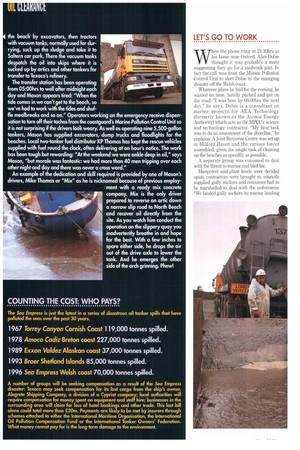the beach by excavators, then tractors with vacuum tanks, normally
Page 42

If you've noticed an error in this article please click here to report it so we can fix it.
used for slur rying, suck up the sludge and take it to Sa!tern car park. There the vacuum tanks despatch the oil into skips where it is sucked up by artics and other tankers for transfer to Texaco's refinery.
The transfer station has been operating from 05:00hrs to well after midnight each day and Mason appears tired: "When the tide comes in we can't get to the beach, so we've had to work with the tides and shuf fle mealbreaks and so on." Operators working on the emergency receive dispensation to turn off their tachos from the coastguard's Marine Pollution Control Unit so it is not surprising if the drivers look weary. As well as operating nine 5,500-gallon tankers, Mason has supplied excavators, dump trucks and floodlights for the beaches. Local two-tanker fuel distributor KP Thomas has kept the rescue vehicles supplied with fuel round the clock, often delivering at an hour's notice. The work has been tough but rewarding: "At the weekend we were ankle deep in oil," says Mason, "but morale was fantastic: we had more than 40 men tripping over each other night and day and there was never a cross word."
An example of the dedication and skill required is provided by one of Mason's drivers, Mike Thomas or "Mix" as he is nicknamed because of previous employment with a ready mix concrete company. Mix is the only driver 111‘. prepared to reverse an artic down 4,4.4 a narrow slip road to North Beach and recover oil directly from the site. As you watch him conduct the operation on the slippery quay you inadvertently breathe in and hope for the best. With a few inches to spare either side, he drops the air out of the drive axle to lower the tank. And he emerges the other side of the arch grinning. Phew!
















































































































